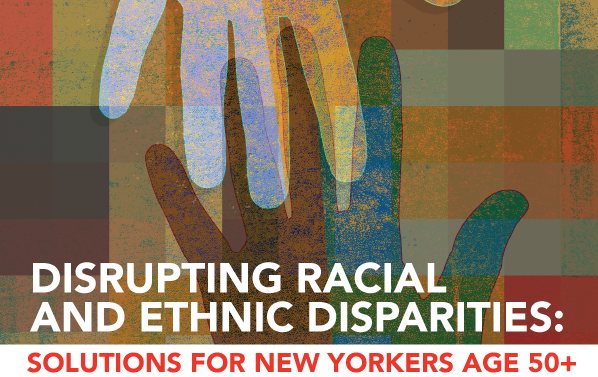AARP Eye Center

HEMPSTEAD, N.Y. - Fewer bank branches and mortgages, less affordable housing costs, more student loan delinquencies and debt collection lawsuits, and higher risk of home foreclosures plague 50+ residents of Long Island’s communities of color.
Those are the key findings of a report compiled by AARP and top advocacy organizations for New York’s communities of color. And they served as a focal point at a forum today at Hofstra University in which experts and community leaders from Long Island brainstormed solutions to disrupt these vast racial and ethnic disparities among Long Islanders 50 and older.
The event, moderated by Hofstra Executive Dean for the National Center for Suburban Studies Lawrence Levy, is the first regional forum in a multi-year statewide campaign AARP and its partners launched in January to #DisruptDisparities in health, economic security and livable communities impacting African American/Black, Hispanic/Latino and Asian American/Pacific Islander communities.
Disrupting Racial and Ethnic Disparities: Solutions for New Yorkers Age 50-Plus , compiled by AARP in partnership with the Asian American Federation, the Hispanic Federation, the NAACP of New York and the New York Urban League, takes a first-ever look at gaps specifically affecting New Yorkers of color 50 and older. The organizations welcome information and potential solutions from the public.
“As Long Island’s population continues to age and become more diverse, our economic, health and livability challenges will mount,” said Bernard Macias, AARP Associate State Director for Long Island. “This marks the first time New York’s and Long Island’s leading advocates have come together to support policy changes focused on older communities of color.”
Key findings on Long Island:
- There are nearly twice as many bank branches per resident in predominantly white neighborhoods as in predominantly non-white neighborhoods. And there are three times more check cashers in communities of color, per capita, than in white neighborhoods.
- Hispanic and Latino homeowners are more likely to pay at least 30 percent of their income on housing - than white homeowners (49 percent vs. 39 percent).
- Bay Shore, Brentwood and Hempstead are among the top 10 communities in New York for risk of foreclosure, neighborhoods with the highest risk are almost exclusively communities of color, including many middle- and upper-income black neighborhoods and those with sizeable numbers of 50+ populations of color, and deed theft scammers are targeting older homeowners because of recent increases in real estate values.
- African American and Latino borrowers received just 14.5% of mortgages in Nassau County and 11.9% in Suffolk despite accounting for 25.1% and 23.2% of the population, respectively.
- Student loan delinquencies are clustered in zip codes that have significant middle-income African-American, Hispanic or Latino populations, suggesting that middle-income people of color are likely to carry unaffordable student loan burdens.
- Residents of communities of color were 40% more likely than residents of predominantly white neighborhoods to be sued by a debt collector – but significantly less likely to be represented by an attorney.
- African Americans are 1.8 times more likely to die from diabetes than whites Suffolk County and Hispanics are at a high risk for disease and death.
These harsh realities have resulted in alarming financial gaps and grave disparities. While forum participants, including LI NAACP Director Tracey Edwards and Urban LI League CEO Theresa Saunders, focused on developing Long Island-specific solutions, AARP and partners are urging some broader solutions at the state level, including:
- Investing in the Community Development Financial Institutions Fund - created in 2007 but never funded - to provide affordable loans and other financial services to communities of color.
- Enacting and promoting property tax exemptions for older homeowners.
- Supporting set-asides for low- and moderate-income older adult households to prevent gentrification in neighborhoods of color.
- Funding community land trusts to ensure access to affordable rents.
- Stepping up enforcement of debt collection laws to combat abuses.
- Creating a “Student Loan Ombudsman,” strengthening consumer protections for loan borrowers and focusing outreach in areas where loan delinquencies are clustered in zip codes with significant middle-income African American and Latino populations
- Enacting legislation to shield homeowners from predatory deed theft schemes and exploitation by fraudulent distressed mortgage consultants.
- Further expanding “telehealth,” enacting a family caregiver state tax credit, requiring cultural and linguistic competency training for all state-licensed health care professionals and establishing a Long-Term Services and Supports Disparities Task Force.
The 60 and over population of New York’s communities of color grew by a staggering 43% between 2000 and 2010 – over 20 times that of the entire population (2.1%) and over five times the 8% increase among the state’s 60+ White population, according to the U.S. Census Bureau. This disproportionately rapid growth is projected to continue in the decades ahead - and could significantly worsen the wide gaps that already exist.
Those interested in following or joining the conversation can visit aarp.org/NYDisruptDisparities , which serves as a platform to host the latest research findings, policy updates and information related to this effort, and a place to contribute ideas and insights (by emailing NYAARP@aarp.org ).
Contact: Jordan McNerney, jmcnerney@aarp.org
AARP is the nation’s largest nonprofit, nonpartisan organization dedicated to empowering people 50 and older to choose how they live as they age. With a nationwide presence and nearly 38 million members, AARP strengthens communities and advocates for what matters most to families: health security, financial stability and personal fulfillment. AARP also produces the nation's largest circulation publications: AARP The Magazine and AARP Bulletin. To learn more, visit www.aarp.org or follow @AARP and @AARPadvocates on social media.
# # #























































